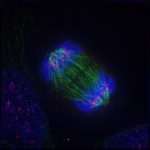Definition
noun
The second stage in the first meiotic division after prophase I, and highlights the alignment of paired homologous chromosomes along a single plane in the center of the cell
Supplement
Meiosis is a specialized form of cell division that ultimately gives rise to non-identical sex cells. There are two successive nuclear divisions: meiosis I and meiosis II. Each of them has four major phases. These are prophase, metaphase, anaphase and telophase. Each of these phases is designated as I or II depending where it occurs, i.e. in meiosis I or in meiosis II.
Metaphase I is the second stage in meiosis I. It follows prophase I, which highlights the pairing of and the exchange of DNA between homologous chromosomes through homologous recombination and crossover at chiasma(ta) between non-sister chromatids.
At metaphase I, the homologous chromosomes move to the center of the cell and orient themselves along an equatorial plane, forming the so-called metaphase plate. It should be noted that because of the previous homologous recombination and crossovers, the four chromatids that make up each pair of homologous chromosomes are genetically dissimilar at this point. The spindle fibers attach to the kinetochores of the centromere, preparing the chromosomal pair to be separated during the next phase, anaphase I.
The main differences between meiotic metaphase I and mitotic metaphase are as follows:
- In mitosis, the chromosomes (each with two chromatids) line up on the metaphase plate whereas in meiosis, the tetrads (where each chromosomal pair has four chromatids joined at the centromere) line up on the metaphase plate.
- In mitosis, the centromeres (i.e. the region containing the kinetochores) lie on the equatorial plane whereas in meiosis, the centromeres are directed towards the poles while the chromatids lie on the equatorial plane.
See also:



